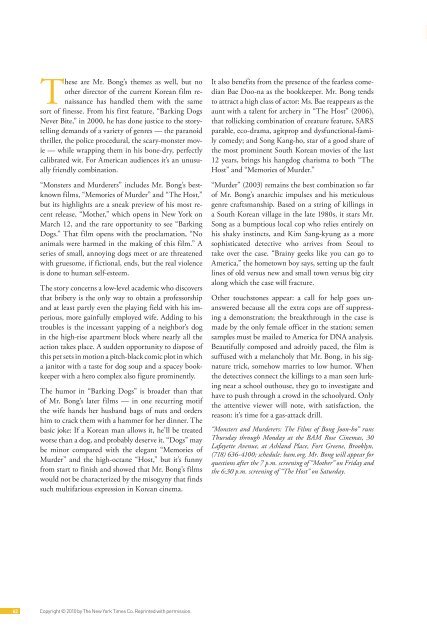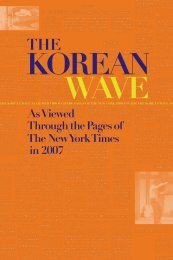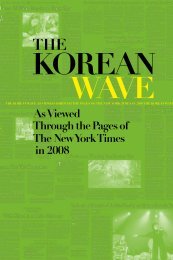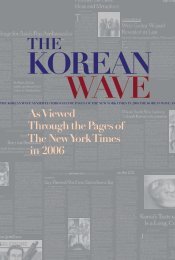The Korean Wave 2010-2011 - Korean Cultural Service
The Korean Wave 2010-2011 - Korean Cultural Service
The Korean Wave 2010-2011 - Korean Cultural Service
Create successful ePaper yourself
Turn your PDF publications into a flip-book with our unique Google optimized e-Paper software.
<strong>The</strong> New York Times, FRIDAY, MARCH 12, <strong>2010</strong>C8<strong>The</strong>se are Mr. Bong’s themes as well, but noother director of the current <strong>Korean</strong> film renaissancehas handled them with the samesort of finesse. From his first feature, “Barking DogsNever Bite,” in 2000, he has done justice to the storytellingdemands of a variety of genres — the paranoidthriller, the police procedural, the scary-monster movie— while wrapping them in his bone-dry, perfectlycalibrated wit. For American audiences it’s an unusuallyfriendly combination.“Monsters and Murderers” includes Mr. Bong’s bestknownfilms, “Memories of Murder” and “<strong>The</strong> Host,”but its highlights are a sneak preview of his most recentrelease, “Mother,” which opens in New York onMarch 12, and the rare opportunity to see “BarkingDogs.” That film opens with the proclamation, “Noanimals were harmed in the making of this film.” Aseries of small, annoying dogs meet or are threatenedwith gruesome, if fictional, ends, but the real violenceis done to human self-esteem.<strong>The</strong> story concerns a low-level academic who discoversthat bribery is the only way to obtain a professorshipand at least partly even the playing field with his imperious,more gainfully employed wife. Adding to histroubles is the incessant yapping of a neighbor’s dogin the high-rise apartment block where nearly all theaction takes place. A sudden opportunity to dispose ofthis pet sets in motion a pitch-black comic plot in whicha janitor with a taste for dog soup and a spacey bookkeeperwith a hero complex also figure prominently.<strong>The</strong> humor in “Barking Dogs” is broader than thatof Mr. Bong’s later films — in one recurring motifthe wife hands her husband bags of nuts and ordershim to crack them with a hammer for her dinner. <strong>The</strong>basic joke: If a <strong>Korean</strong> man allows it, he’ll be treatedworse than a dog, and probably deserve it. “Dogs” maybe minor compared with the elegant “Memories ofMurder” and the high-octane “Host,” but it’s funnyfrom start to finish and showed that Mr. Bong’s filmswould not be characterized by the misogyny that findssuch multifarious expression in <strong>Korean</strong> cinema.It also benefits from the presence of the fearless comedianBae Doo-na as the bookkeeper. Mr. Bong tendsto attract a high class of actor: Ms. Bae reappears as theaunt with a talent for archery in “<strong>The</strong> Host” (2006),that rollicking combination of creature feature, SARSparable, eco-drama, agitprop and dysfunctional-familycomedy; and Song Kang-ho, star of a good share ofthe most prominent South <strong>Korean</strong> movies of the last12 years, brings his hangdog charisma to both “<strong>The</strong>Host” and “Memories of Murder.”“Murder” (2003) remains the best combination so farof Mr. Bong’s anarchic impulses and his meticulousgenre craftsmanship. Based on a string of killings ina South <strong>Korean</strong> village in the late 1980s, it stars Mr.Song as a bumptious local cop who relies entirely onhis shaky instincts, and Kim Sang-kyung as a moresophisticated detective who arrives from Seoul totake over the case. “Brainy geeks like you can go toAmerica,” the hometown boy says, setting up the faultlines of old versus new and small town versus big cityalong which the case will fracture.Other touchstones appear: a call for help goes unansweredbecause all the extra cops are off suppressinga demonstration; the breakthrough in the case ismade by the only female officer in the station; semensamples must be mailed to America for DNA analysis.Beautifully composed and adroitly paced, the film issuffused with a melancholy that Mr. Bong, in his signaturetrick, somehow marries to low humor. Whenthe detectives connect the killings to a man seen lurkingnear a school outhouse, they go to investigate andhave to push through a crowd in the schoolyard. Onlythe attentive viewer will note, with satisfaction, thereason: it’s time for a gas-attack drill.“Monsters and Murderers: <strong>The</strong> Films of Bong Joon-ho” runsThursday through Monday at the BAM Rose Cinemas, 30Lafayette Avenue, at Ashland Place, Fort Greene, Brooklyn,(718) 636-4100; schedule: bam.org. Mr. Bong will appear forquestions after the 7 p.m. screening of “Mother” on Friday andthe 6:30 p.m. screening of “<strong>The</strong> Host” on Saturday.<strong>The</strong> last monster to run wild through BongJoon-ho’s imagination was an enormous creaturefrom the watery deep. A different menacestorms through “Mother,” the fourth feature fromthis sensationally talented South <strong>Korean</strong> filmmaker,though she too seems to spring from unfathomabledepths. Unlike the beast in “<strong>The</strong> Host” — a catastrophicbyproduct of the American military — themonster in “Mother” doesn’t come with much of abackstory, which suggests that she is a primal force, inother words, a natural.She is and she isn’t as Mr. Bong reveals through akinked narrative and a monumental, ferocious performanceby Kim Hye-ja as the title character. Writtenby Mr. Bong, sharing credit with Park Eun-kyo,“Mother” opens as a love story that turns into a crimestory before fusing into something of a criminal lovestory. Nothing is really certain here, even the film’sgenre, and little is explained, even when the charactersfill in the blanks. Though richly and believably drawn,Mr. Bong’s characters are often opaque and mysterious,given to sudden rages, behavioral blurts and hiccupsof weird humor. But it’s this very mystery thatcan make them feel terribly real.None are truer, more disturbingly persuasive thanMother, who lives with her 27-year-old son, Do-joon(Won Bin), in cramped quarters adjoining her tinyapothecary. Beautiful and strangely childlike, Dojoondoesn’t seem right in the head: he’s forgetful,seemingly naïve, perhaps retarded. (When he tries toremember something, he violently massages both sidesof his head in an exercise that Mother, without apparentirony, calls “the temple of doom.”) But if he runsFierce Love:Better Not MakeThis Mom AngryBy MANOHLA DARGISa little slow, Mother runs exceedingly fast, as you seeshortly after the movie opens when, while playing witha dog one bright day, Do-joon puts himself in the pathof an oncoming BMW, which leaves him dazed if notparticularly more addled.You watch the accident unfold alongside Mother, whobusily chops herbs with a big blade in her darkenedshop while casting worried glances at Do-joon as hegoofs off across the street. From her vantage point,he looks as centered within the shop’s front door as alittle prince inside a framed portrait. <strong>The</strong> dim interiorand bright exterior only accentuate his body — thedaylight functions as a kind of floodlight — whichputs into visual terms the idea that he is the only thingthat Mother really sees. Mr. Bong may like narrativedetours, stories filled with more wrong turns than amaze, but he’s a born filmmaker whose images — thespilled water that foreshadows spilled blood — tellmore than you might initially grasp.He’s also a filmmaker who finds great, unsettling darkcomedy in violence, and once again the blood does run,if somewhat less generously than in “<strong>The</strong> Host” andhis often brilliant “Memories of Murder.” AlthoughDo-joon seems to recover from his accident, the eventsets off a chain of increasingly violent incidents thatculminate in the murder of a local schoolgirl, Ah-jung(Moon Hee-ra), whose body is found slumped over aroof wall in the village, positioned, one character says,like “laundry.” Do-joon is summarily arrested for thedeath after an incriminating golf ball is found at thescene. Mad with grief, Mother sets off to clear him andbegins furiously rooting around the village in search ofthe killer.62 Copyright © <strong>2010</strong> by <strong>The</strong> New York Times Co. Reprinted with permission.63





